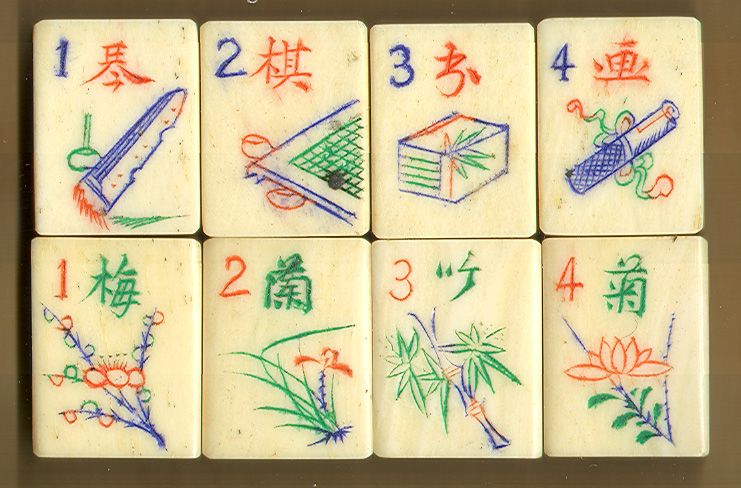We'll begin today's post with a close up of a painting in the collection of the Metropolitan Museum of Art. You will quickly see cranes in water, some flying and even swooping down(!), and bamboo, that every present plant that means so much to the Chinese. It is said that in China alone, more than 300 varieties of bamboo grow. Some of you know that Bamboo was probably the first material used to make mahjong tiles. Craftsmen took the images that were on paper cards and carved them into the harder bamboo surface. Bamboo was cheap (perhaps even free?) and abundant. It is no surprise it appears so often on Mahjong tiles, sometimes as itself in a pot, and sometimes worked into the scenes on the tiles and boxes.
Above we have the crane and the bamboo stalk, both part of the Bamboo suit, as we all now call it. But calling it bamboo, certainly in the early days of the game, was something of a misnomer. Through the years the suit certainly morphed into looking like bamboo stalks, and thus can properly be called that today, but in the early days it was called String of Cash, close to its original money-based suit inspiration. You may want to read Michael Stanwick's website for more information about the development of the suits.
As many of you already know, bamboo is one of the Four Gentlemen, and is one of the plants frequently appearing on Flower tiles.
The Flower in the top row, tile #3 is the Bamboo. It is one of the easiest Chinese characters to read, I think.
The above top row #3 tile is also a bamboo, looking very much like we would expect.
From Wikipedia:
"The Four Gentlemen, also called the Four Noble Ones, in Chinese art refers to four plants: the orchid, the bamboo, the chrysanthemum, and the plum blossom.[1][2] The term compares the four plants toConfucianist junzi, or "gentlemen". They are most typically depicted in traditional ink and wash painting and they belong to the category of bird-and-flower painting in Chinese art.
The Four Gentlemen have been used in Chinese painting since the time of the Chinese Song Dynasty (960–1279) because of their refined beauty, and were later adopted elsewhere in East Asia by artists in Korea, Japan, and Vietnam. As they represent the four different seasons (the orchid for spring, the bamboo for summer, the chrysanthemum for autumn, and the plum blossom for winter), the four are used to depict the unfolding of the seasons through the year."
So, the Bamboo Flower tiles we have just seen show us Bamboo growing out of a pot, and a close-up of it growing in the ground.
Above we see a much more simplified bamboo, but recognizable nevertheless. Once again on #3, the lower row of tiles, with a slightly different rendition of the Chinese character.
And here it is again, this time just represented in the Chinese character seen on the #3 tile.
The third and fifth images are from the collection of mahjongmahjong
We end the post by looking at an ink painting of bamboo
dating from the Ming dynasty, in the collection of the Metropolitan Museum of Art. You can easily see the nodes on the stalks, and the simple leaves of the plant, very much like what we see on Mahjong tiles.
The book I wrote with Ann Israel is being published by Tuttle. To see more about it:
www.mahjonggtheartof thegame.com
To order it click here:
http://www.barnesandnoble.com/w/mah-jongg-ann-israel/1118759459?ean=9784805313237
or here from Amazon
http://www.amazon.com/Mah-Jongg-Collectors-Guide-Tiles/dp/4805313234/ref=sr_1_7?ie=UTF8&qid=1414844427&sr=8-7&keywords=mah+jongg







